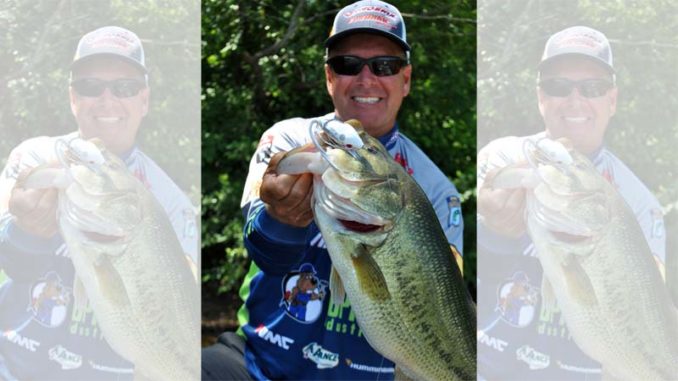
Early morning topwater bite is an August event
There’s a lot about dawn to like. It’s a quiet time of day, and not many things moving around. The world is just waking up.
But largemouth bass have been up all night. And they’re about to enjoy a last little bit of activity before shutting down for another hot, August day.
This is not a great month to be a bass fisherman, unless you use the best hours of the day. Hey, fish gotta eat, and I want to be out there catching them before breakfast. I can pick up a biscuit on the way home from the lake.
Early means early
August is a month when an early morning topwater bite can be really good. And I like to catch fish on topwater baits. But when you talk about early morning, I’m talking about being out there before the sun rises, when the orange glow is just barely starting to dent the horizon. I want to be out there at the crack of daylight, not an hour after dawn, but out there by 5:30 a.m., something like that.
The period between 5:30 and 8 a.m. can be a great time to catch bass. Fish will be as active at that time as they are all day. The water has had all night to cool down before the sun rises, shines on it, and heats it up again. When the water is cool, bass will come up and roam the banks. And in August, there are more of them there than in June and July, when fish seem to live deeper.
Bass don’t mind hot water as much as they mind low oxygen levels
Bass live closer to the surface in August because the oxygen in deeper water is bad. So they’ve got to come up shallow to find oxygen. When I won the Bassmaster Classic in Louisiana in August 1999, I caught all my fish in 5 feet of water or less. And the surface temperature that week was 90 degrees. Bass can stand hot water a lot better than they can stand water that doesn’t carry much dissolved oxygen.
If I’ve convinced you to get up early enough to be on the lake by 5:30, I need to explain how we’re going to catch fish. First, I’m going to look for the best shallow cover that a lake has. I’ll keep my eyes open for any baitfish I see. I look for grass, because it seems like baitfish will get in grass this time of year. And you can catch a lot of quality bass around them.
Presence of grass will determine lure choice
Because I’m only going to fish for three hours or so, I concentrate on fishing three or four different areas and covering a lot of water in those areas. I like to concentrate on long, flat points, because fish can move up on them to feed. If grass is present on the point, I like to fish a frog bait like a Terminator frog or a buzzbait.
If there’s no grass, I like to fish a wake bait like a Rapala BX Waking Minnow. You’ll get some vicious strikes his time of year on a wake bait, which has a diving lip but stays so close to the surface that it puts off a wake, like the Redfins a striper fisherman might use. On a lake like Wateree, where the entire lake is full of shallow grass, I’ll start with a frog. At Clarks Hill or Murray, I’ll start with a wake bait.
A little wind is a big help
I fish a wake bait with a 7-foot, medium-action Bass Pro Shops Carbonlite rod. I like 14-pound XPS monofilament. You don’t want to use fluorocarbon because the weight of the line will pull your lure down a little. If I’m fishing a frog, I’ll go to a medium heavy rod and a reel loaded with 50-pound braid. That helps you to pull a bass out after it hits a frog.
I think all these baits work better if you’ve got just a little wind, just the slightest wind. If it is blowing harder, I’ll throw something like a D-Shad, some kind of a soft-plastic jerkbait. But typically in August, you don’t have much wind early in the morning.
I think a frog bait works best if you parallel the outside edge of the grass. I’ll cast it out, let it sit, move it a little, then let it sit still some more; that lets them find it. Other times, I’ll fish it erratically, moving it erratically, then stopping it and letting it sit. They often have to turn and find it. With a wake bait, you’re just making a slow, consistent retrieve, allowing the bait’s wobble to attract fish.
Keep a follow-up bait tied onto one rod
One thing I always have tied on when I’m fishing topwaters is a follow-up bait to throw if a bass makes a big swirl or splash and misses. I always keep a Senko tied on — green pumpkin or purple/green. And I rig it wacky style when I’m fishing it as a follow-up bait. I want to throw it right where I missed the fish, because the fish will often turn and look for the bait after missing it. And if you can have another bait sinking down slowly in front of it, you’ve got a good chance to get a strike and a hookup.
So instead of taking the hot days of August off, just compress your fishing efforts into those few hours right before and after dawn breaks. If you live in the Lowcountry, you’ll be up later in the month deer hunting anyway. You can get a biscuit on the way home after catching a couple of 5-pounders, catch a little nap, and you’re ready for the rest of the day.



